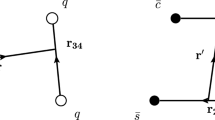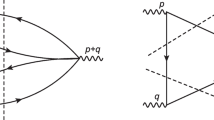Abstract
\(J^{pc}=\) \(0^{++}\) and \(2^{++}\) states of all charm tetraquark (\([cc][\bar{c}\bar{c}]\)) are investigated in the framework of non-relativistic QCD using diquark-antidiquark coulomb plus power potential of the type \(V_{d\bar{d}}=k_{s} \frac{\alpha _s}{r} + A r^{\nu }\) with power index \(\nu \) varying from 0.1 to 2. We have included the spin hyperfine interaction to obtain masses of \(J^{pc}=\) \(0^{++}\) and \(2^{++}\) states of all charm tetraquark. We have computed branching ratios and decay widths of the main, hidden and open charm channels of tetraquark state with the help of the potential model parameters, masses and the respective radial wave function obtained by our non-relativistic quark model. Our theoretical predictions of the masses as well as the branching ratios and decay widths at power index \(\nu \)=1 are found to be in good accordance with other available theoretical predictions.





Similar content being viewed by others
Data Availability
This manuscript has no associated data or the data will not be deposited. [Authors’ comment: The article includes all the theoretical data that has been calculated or examined with other available experimental as well as theoretical data supporting the findings of this study.]
References
M. Gell-Mann, Phys. Lett. 8, 214 (1964)
G. Zweig, An SU3 model for strong interaction symmetry and it’s breaking, CERNTH-401 (1964)
S.K. Choi et al., (Belle Collaboration) Phys. Rev. Lett. 91, 262001 (2003)
R.J. Jaffe, Phys. Rev. D 15, 267 (1977)
I.M. Barbour, D.K. Ponting, Nucl. Phys. B 149, 534–546 (1979)
L. Heller, J.A. Tjon, Phys. Rev. 32(3), 755–763 (1985)
B. Silvestre-Brac, C. Semay, Z. Phys. C 59, 457–470 (1993)
S.K. Choi et al., (Belle Collaboration) Phys. Rev. Lett. 100, 142001 (2008)
R. Aaij et al., (LHCb Collaboration) Phys. Rev. Lett. 112, 222002 (2014)
M. Ablikim et al., (BESIII Collaboration) Phys. Rev. Lett. 111, 242001 (2013)
A. Bondar et al., (Belle Collaboration) Phys. Rev. Lett. 108, 122001 (2012)
H.X. Chen, W. Chen, X. Liu, S.L. Zhu, Phys. Rep. 639, 1 (2016)
A. Esposito, A. Pilloni, A.D. Polosa, Phys. Rep. 668, 1 (2016)
R. Aaij et al. [LHCb Collaboration] (2020), arXiv:2006.16957 [hep-ex]
M.N. Anwar et al., Eur. Phys. J. C 78, 647 (2018)
R. Aaij et al., (LHCb Collaboration), Phys. Lett. B 707, 52 (2012)
R. Aaij et al., (LHCb Collaboration), JHEP, 1706: 047 (2017); Erratum: [JHEP, 1710: 068 (2017)]
M. Aaboud et al., (ATLAS Collaboration), Eur. Phys. J. C 77, 76 (2017)
V. Khachatryan et al., (CMS Collaboration). JHEP 1409, 094 (2014)
A.K. Rai, J.N. Pandya, P.C. Vinod Kumar, Nucl. Phys. A 782, 406 (2007)
A.K. Rai, D.P. Rathaud, Eur. Phys. J. C 75, 462 (2015)
D.P. Rathaud, A.K. Rai, Indian J. Phys. 90, 1299 (2016)
D.P. Rathaud, A.K. Rai, Eur. Phys J. Plus 370, 132 (2017)
Y. Iwasaki, Prog. Theor. Phys. 54, 492–503 (1975)
M. Wagner et al., J. Phys: Conf. Ser. 503, 012031 (2014)
W. Chen, Phys. Lett. B 773, 247 (2017)
Z. Ghalenovi, M.M. Sorkhi, Eur. Phys. J. Plus 135, 399 (2020)
A. Ali, L. Maiani, A.D. Polosa, Multiquark Hadrons (Cambridge University Press, Cambridge, 2019)
V.R. Debastiani, F.S. Navarra, Chin. Phys. C 43, 013105 (2019)
W. Lucha et al., Effective potential models for hadrons HEPHY-PUB 621/95 (1995)
A. Martin, Phys. Lett. B 93, 338 (1980)
N. Barik, S.N. Jena, Phys. Lett. B 97, 261 (1980)
H.A. Bethe, E.E. Salpether, Quantum Mechanics of atoms of one-and two-electrons (Springer, Berlin, 1957)
M.B. Voloshin, Prog. Part. Nucl. Phys. 61, 455 (2008)
Rohit Tiwari, D.P. Rathaud, A.K. Rai. (2021) arxiv:2108.04017
S. Patel, M. Shah, P.C. Vinodkumar, Mass spectra of four-quark states in the hidden charm sector. Eur. Phys. J. A 50, 131 (2014)
F. Stancu, Group theory in subnuclear physics, Oxford Stud. Nucl. Phys. 19 (1996)
T. Bhavsar, M. Shah, S. Patel, P.C. Vinodkumar, Masses of tetraquark states in the hidden charm sector above DD\(_*\) threshold, Nucl. Phys. A, 1000 (2020)
Y. Iwasaki, Phys. Rev. Lett. 36, 1266 (1976)
S. Esau et al., Phys. Rev. D 100, 074025 (2019)
D. Ebert, R.N. Faustov, V.O. Galkin, W. Lucha, Phys. Rev. D 76, 114015 (2007)
Ahmed Ali, Luciano Maiani, Antonio D. Polosa, Multiquark hadrons (Cambridge University Press, Cambridge, 2019)
C. Becchi, J. Ferretti, A. Giachino, L. Maiani, E. Santopinto, Phys. Lett. B 811, 135952 (2020)
Berestetskii, Vladimir Borisovich, Evgenii Mikhailovich Lifshitz, and Lev Petrovich Pitaevskii. Quantum Electrodynamics: Volume 4. Vol. 4. Butterworth-Heinemann, (1982)
A.K. Rai, B. Patel, P.C. Vinodkumar, Phys. Rev. C 78, 55202 (2008)
Particle Data Group, P.A. Zyla et al., Volume 2020, Issue 8, (August 2020), 083C01, https://doi.org/10.1093/ptep/ptaa104
D. Ebert, Phys. Rev D 67, 014027 (2003). [arXiv:hep-ph/9601263v1] Scientific Lecture Notes in Physics: Vol. 78, 3rd edition (2010)
Author information
Authors and Affiliations
Corresponding author
Additional information
Communicated by Eulogio Oset.
Rights and permissions
Springer Nature or its licensor (e.g. a society or other partner) holds exclusive rights to this article under a publishing agreement with the author(s) or other rightsholder(s); author self-archiving of the accepted manuscript version of this article is solely governed by the terms of such publishing agreement and applicable law.
About this article
Cite this article
Mistry, R., Majethiya, A. Branching ratios and decay widths of the main, hidden and open charm channels of tetraquark state. Eur. Phys. J. A 59, 107 (2023). https://doi.org/10.1140/epja/s10050-023-01023-6
Received:
Accepted:
Published:
DOI: https://doi.org/10.1140/epja/s10050-023-01023-6




